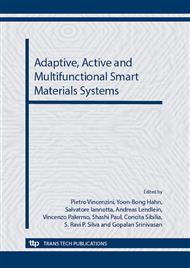p.65
p.71
p.77
p.82
p.86
p.96
p.103
p.108
p.118
Novel Adaptive Damping Systems Based on Magnetorheological Fluids
Abstract:
Adaptive damping systems based on magnetorheological (MR) fluids allow the continuous control of vibration damping forces depending on the current conditions. In magnetorheological dampers known so far, the magnetic field for the control of the MR fluid is generated by the coil of an electromagnet. Two novel concepts for the magnetic circuit in magnetorheological dampers have been proven where hybrid magnetic circuits consisting of at least one permanent or hard magnet and an electromagnet are used. In the first concept, the electromagnet is combined with two permanent magnets, whose magnetization cannot be modified even by strong magnetic fields of the electromagnet. The main advantage of this configuration is the improved fail-safe behaviour of the damper in case of a power failure. In the second approach, the electromagnet is combined with a hard magnet, whose magnetization can be modified by the electromagnet. This configuration leads to high energy efficiency, because electric power is only required in short pulses for the switching of the hard magnet. Magnetic circuits with the combination of different magnetic field sources were designed supported by simulations of the magnetic flux distribution. Demonstration models for magnetorheological dampers with the distinguished magnetic circuits were constructed and their performances were tested. The results of the investigations are described in this contribution.
Info:
Periodical:
Pages:
86-95
Citation:
Online since:
September 2012
Authors:
Price:
Сopyright:
© 2013 Trans Tech Publications Ltd. All Rights Reserved
Share:
Citation:


